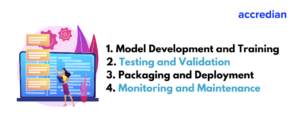Have you ever wondered what happens to machine learning models after they are developed?
How do organizations ensure that these models continue to deliver accurate and reliable predictions in real-world scenarios?
The answer lies in the realm of ModelOps, a transformative approach that brings together the power of DevOps and machine learning operations.
In this blog, we will take you on an enlightening journey into the world of ModelOps, exploring its significance, principles, and how it empowers organizations to scale and deploy machine learning models effectively.
Introduction to ModelOps: Empowering the Future of Machine Learning
Are you ready to unlock the full potential of your machine-learning models?
Join us as we dive into the fascinating realm of ModelOps!
Understanding ModelOps: Bridging the Gap between Development and Deployment
ModelOps is a practice that focuses on streamlining and operationalizing the entire machine learning lifecycle, from model development to deployment and beyond. It aims to bridge the gap between data science teams and IT operations, ensuring seamless collaboration and efficient management of machine learning models.
In today’s fast-paced and data-driven world, organizations are increasingly relying on machine learning models to gain valuable insights, make informed decisions, and automate processes. However, developing a model is just the first step in the journey.
To truly unlock the value of machine learning, organizations need to implement a systematic approach that enables seamless integration, monitoring, and maintenance of these models in real-world scenarios. This is where ModelOps comes into play.
The Importance of ModelOps in the Machine Learning Lifecycle
ModelOps plays a crucial role in realizing the full potential of machine learning models. By applying DevOps principles to machine learning operations, ModelOps enables organizations to tackle challenges related to scalability, reproducibility, model governance, and deployment efficiency.
Traditionally, the development and deployment of machine learning models have been treated as separate and disconnected processes. Data scientists focus on building models using various algorithms and techniques, while IT operations teams handle the deployment and maintenance of these models in production environments.
This disjointed approach often leads to inefficiencies, delays, and difficulties in ensuring model accuracy and reliability.
ModelOps breaks down these silos and establishes a collaborative environment where data scientists, software engineers, and operations teams work together throughout the entire machine learning lifecycle.
By aligning the goals, expertise, and workflows of these teams, ModelOps enables organizations to seamlessly transition models from development to deployment and ensures their continuous performance and optimization.
Key Principles of ModelOps
1. Collaboration and Communication
Effective collaboration and communication between data scientists, software engineers, and operations teams are critical in ModelOps. This involves establishing clear channels of communication, fostering a shared understanding of model requirements, and promoting frequent collaboration and feedback loops.
By encouraging cross-functional collaboration, organizations can ensure that models meet business needs, are deployable in real-world scenarios, and can be easily maintained.
2. Continuous Integration and Delivery
Continuous integration and delivery (CI/CD) practices, borrowed from DevOps, are essential in ModelOps. This involves automating the integration, testing, and deployment of models, enabling rapid and reliable model updates.
By implementing CI/CD pipelines for models, organizations can ensure that new versions are thoroughly tested, validated, and seamlessly deployed into production environments.
3. Monitoring and Governance
ModelOps incorporates robust monitoring and governance mechanisms to track model performance, identify anomalies, and ensure compliance with regulations and ethical standards. This involves implementing real-time monitoring solutions that provide insights into model behavior, detecting potential issues, and triggering proactive actions.
Additionally, governance practices such as version control, model documentation, and model explainability are crucial to ensure transparency, auditability, and compliance.
ModelOps Workflow: From Development to Deployment
ModelOps follows a well-defined workflow that encompasses various stages of the machine learning lifecycle:
1. Model Development and Training
Data scientists develop and train machine learning models using appropriate algorithms and techniques, ensuring accuracy, performance, and generalization. They leverage a wide range of data sources, feature engineering techniques, and model architectures to build robust and reliable models.
2. Testing and Validation
Models undergo rigorous testing and validation to assess their reliability, generalization, and adherence to predefined metrics. This involves using representative datasets, running simulations, and conducting performance evaluations to ensure that models perform as expected and meet the desired criteria.

3. Packaging and Deployment
Once validated, models are packaged into deployable artifacts and integrated into production environments, making them ready for real-time predictions. Model packaging involves encapsulating the model, associated dependencies, and pre-processing pipelines into a deployable format that can be easily replicated across different environments.
4. Monitoring and Maintenance
Deployed models are continuously monitored to ensure their ongoing performance, detect anomalies, and identify degradation. Monitoring involves collecting relevant metrics, tracking model behavior, and comparing performance against defined thresholds.
Regular maintenance and updates are carried out to address issues, retrain models with new data, and incorporate enhancements based on user feedback and evolving business requirements.
Benefits of Adopting ModelOps
1. Improved Model Performance and Accuracy
By focusing on continuous testing, monitoring, and maintenance, ModelOps ensures that models remain accurate, reliable, and up-to-date. This leads to improved performance and increased confidence in the predictions generated by the models.
2. Faster Time-to-Market
ModelOps enables organizations to rapidly deploy and iterate models, reducing the time it takes to put machine learning solutions into production. This accelerated time-to-market allows organizations to seize opportunities, respond to market demands, and stay ahead of the competition.
3. Enhanced Collaboration and Efficiency
ModelOps fosters collaboration between teams, breaking down silos and promoting efficient knowledge-sharing and iteration cycles. By aligning the goals and expertise of data scientists and operations teams, organizations can streamline workflows, reduce bottlenecks, and ensure smoother handovers during the model development and deployment process.
4. Better Governance and Compliance
With ModelOps, organizations can establish robust governance frameworks, ensuring adherence to regulatory requirements, ethical standards, and data privacy regulations. By implementing version control, model documentation, and explainability techniques, organizations can enhance transparency, accountability, and compliance.
Challenges and Considerations in Implementing ModelOps
1. Infrastructure Complexity
Implementing ModelOps requires organizations to have the necessary infrastructure and resources to support the development, deployment, and monitoring of machine learning models. This includes robust computing resources, scalable storage, and appropriate software frameworks for model training and inference.
2. Version Control and Reproducibility
Maintaining version control and ensuring the reproducibility of models can be challenging, especially when dealing with large-scale models, complex data pipelines, and frequent updates. Organizations must establish effective versioning mechanisms, data lineage tracking, and documentation practices to ensure the reproducibility and traceability of models.
3. Data Quality, Scalability, and Security
ModelOps relies heavily on the quality, scalability, and security of data. Organizations need to address data quality issues, ensure data pipelines can handle large volumes of data, and implement robust security measures to protect sensitive information used in the model development and deployment processes.
Future of ModelOps: Trends and Innovations
1. Automated Model Monitoring
Advancements in automated model monitoring techniques, including anomaly detection, drift detection, and performance tracking, are revolutionizing ModelOps. Organizations can leverage AI-driven monitoring solutions to proactively identify issues, trigger alerts, and automate remediation actions.
2. Explainability Techniques
The interpretability and explainability of machine learning models are gaining prominence in ModelOps. Techniques such as model explainability, feature importance analysis, and model-agnostic interpretability methods are being adopted to enhance transparency, build trust, and meet regulatory requirements.
3. Model Versioning
In the era of continuous model updates, versioning becomes crucial for tracking model changes, managing model deployments, and ensuring reproducibility. Innovations in model versioning tools and practices are simplifying the management of model versions and facilitating seamless collaboration among teams.
4. Cloud-based Infrastructure and Containerization
Cloud computing and containerization technologies are revolutionizing ModelOps by providing scalable and efficient infrastructure for model development, deployment, and monitoring. Organizations can leverage cloud platforms and containerization technologies to simplify infrastructure management, ensure scalability, and enable seamless integration with existing systems.
ModelOps is the missing piece in the machine learning puzzle, providing organizations with a holistic approach to managing and deploying models effectively. By embracing ModelOps, organizations can unlock the true potential of their machine learning initiatives, drive innovation, and gain a competitive edge in the evolving data-driven landscape.
Are you ready to embark on your ModelOps journey?
By integrating development, deployment, and maintenance, ModelOps empowers organizations to turn their machine-learning models into scalable, reliable, and impactful solutions.
Stay ahead of the curve, and embrace the transformative power of ModelOps today!
 Pin
PinJoin ACCREDIAN’s Data Science certifications and start your journey from insights to algorithms today! With our extensive collection of data resources, pursue a fulfilling career in data science.
Let’s make your data-driven dreams a reality!
Contact us for any questions or comments.






